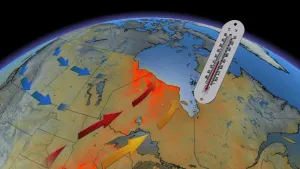
Oceans can be restored within 30 years, study finds
Researchers have determined the steps we need to take to heal our oceans from the impacts of pollution, ocean acidification and climate change.
From plastics in our oceans to the latest coral reef bleaching, it often seems hope for a clean and healthy planet is dwindling. A new study finds that despite the damage marine ecosystems have suffered over the past few decades, oceans can be restored to vibrant and healthy habitats by 2050.
And now we know how to do it.
The study states that overfishing, ocean acidification and pollution have caused ecosystems to suffer “catastrophic declines” that are undermining ocean productivity and biodiversity. Today over 30 per cent of fish stocks are overfished, 30-50 per cent of vulnerable marine habitats have been lost, and many marine species are facing extinction.
RELATED: 'Blood water' continues to spew into the ocean off the coast of Vancouver Island
While the current trends are alarming, previous regulations that protect marine animals have seen great success. Coral reefs in the Marshall Islands that were inundated with 76 megatons of nuclear tests in 1958 have largely recovered. In 1968 there were only a few hundred humpback whales left, due to the whaling industry. However, increased awareness and international regulations have helped their population grow to over 40,000 individuals today.

A school of fish near Iriomote island, Japan. Credit: Hiroko Yoshii/ Unsplash
These recoveries have helped researchers understand how resilient oceans can be. The study states that our efforts should not just be focused on conservation and improving sustainability, but should be centred around rebuilding depleted ecosystems and marine populations to avoid potential tipping points with irreversible damages.
The Living Blue Planet Report estimated that the global abundance of marine animal populations declined by 49 per cent between 1970 and 2012 and current recovery rates range from 2 to 10 per cent each year, depending on natural environmental processes and conservation efforts. Using these statistics, the researchers found that 2.95 per cent of marine animal populations can recover each year with efforts to reach pre-disturbance baselines, predicting a full restoration of all oceans in 18 to 25 years.
Such a feat will be an expensive endeavour with an estimated cost of at least $10 to 20 billion USD per year, but the economic return from this cost will be around $10 USD for each $1 USD spent and will create over one million jobs. While the projections are reassuring that restoring the oceans is a realistic and achievable goal, the researchers state that global temperatures and pollution are still increasing. They conclude that a substantial recovery of 50 to 90 per cent of oceans could be a more realistic target for rebuilding marine life.
See below for a look at the actions that the study says will make the most impact to restore our oceans.
REDUCE RISK OF EXTINCTION
The IUCN Red List of Threatened Species monitors the health of the world’s species and found that the proportion of marine species that are at risk of global extinction decreased from 18 per cent in 2000 to 11.4 per cent in 2014. Several marine species that the study says “were on the brink of extinction” have also made notable rebounds. The northern elephant seals have recovered from 20 breeding individuals in 1880 to over 200,000 today and there has been a 1,410 per cent increase in grey seal populations in eastern Canada since 1977.
Sea turtles are one of the most prominent faces of ocean degradation as the danger of plastic straws gained traction over the past few years. The global attention appears to have paid off as the study states that even though most sea turtles are still endangered, the majority of their populations have increased, with the green turtle nesting populations growing between 4 to 14 per cent per year.
FISHERIES MANAGEMENT
Marine experts are able to calculate the minimum amount of fish that are needed to maintain the health of the population and how many fish can be removed from a stock during any specific time period.
The collapse of the cod fishery in Atlantic Canada during the early 1990s was timed when the introduction of sustainable practices. For 500 years this region was shaped by abundant northern cod stocks, but faced a moratorium after the spawning biomass fell about 93 per cent in 30 years.
The study says that depleted fish populations can be rebuilt at local and regional scales through effective management strategies, which include catch and effort restrictions, closed areas, regulating fishing capacity and gear, catch shares and co-management arrangements. Since each region has unique socio-economic circumstances, the researchers note that solutions will need to be tailored to the local context to address challenges such as the lack of alternative employment and unregulated fishing activities.
WATER-QUALITY IMPROVEMENT
Pollution from ships, including oil and sewage, as well as uncontrolled dumping of garbage and noxious substances prompted several international agreements to reduce these practices that were both intentional and accidental. The International Convention for the Prevention of Pollution from Ships (MARPOL) and the Stockholm Convention have been cited as regulations that helped set a standard for oceanic water quality and were supported by national and regional policies.
The researchers from the study note that plastic pollution falls under this category and say that it is a growing problem, with estimates indicating that between 4.8 to 12.7 million metric tons are released per year.

Ocean pollution near Punta Cana, Dominican Republic. Credit: Dustan Woodhouse/Unsplash
HUNTING REGULATIONS
Commercial whaling and overexploitation of marine animals have prompted several international regulations to better manage these practices. Here, the researchers note that the Convention on International Trade of Endangered Species (CITES) in 1975 and the Moratorium on Commercial Whaling in 1982 have effectively protected wildlife because they were supplemented by national initiatives to protect endangered species and their breeding habitats.
HABITAT PROTECTION AND RESTORATION
Marine Protected Areas (MPAs) are considered to be a comprehensive management tool as they act as a shelter for ocean life and habitats. They can be created by federal, provincial, and territorial governments and they cover 6.35 per cent of all of ocean areas on Earth. The study states that the growth rate of MPAs is roughly 8 per cent each year and notes that other habitat protection and restoration projects are also improving water quality and restoring coral reefs.
The researchers say that the efforts to rebuild the oceans cannot aim to return to a specific past reference point because there is too much variation throughout history to choose a baseline. Oceans have also changed considerably over time with at least 20 extinctions of marine species. Actions that will have the biggest impacts will increase the abundance of key habitats that are functional, resilient and can support the growing needs of an additional two to three billion people by 2050.











